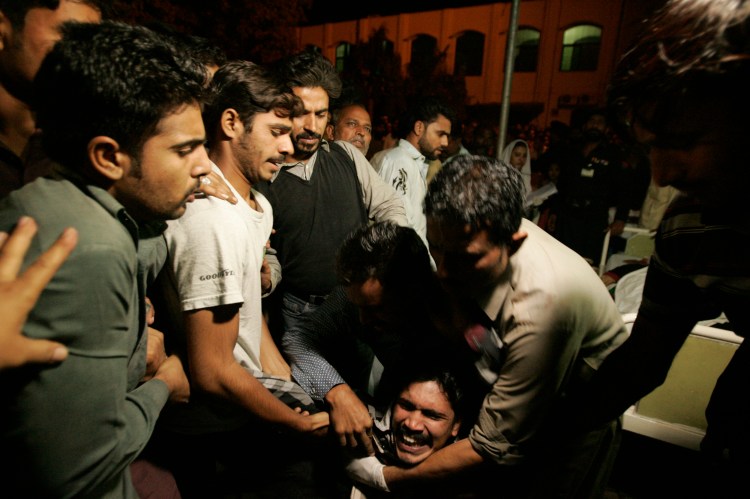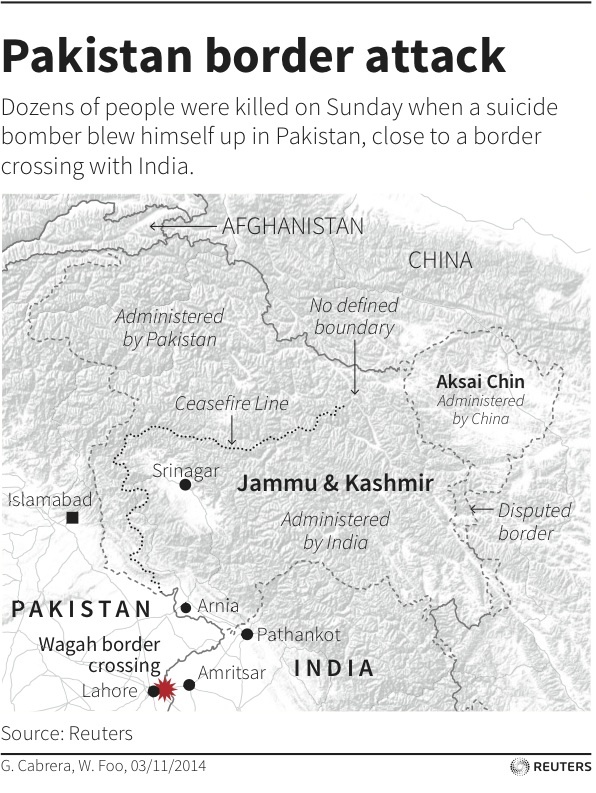WAGAH, Pakistan — A Pakistani police officer says the death toll from the suicide bombing near the country’s border with India has risen to 60.
Nadeem Khokhar says Sunday’s attack also wounded more than 100 people, who are still in hospital.
It was the deadliest attack on Pakistani soil this year.
The explosion at the Wagah crossing occurred just as the daily flag-lowering ceremony conducted by security forces on both sides was concluding. The blast tore through a parking lot, damaging several shops and a restaurant near the Pakistani city of Lahore.
Police the people killed included numerous children.
The attack, which appeared to be in retaliation for Pakistan’s ongoing military operation against Islamist extremists, overwhelmed hospitals in Lahore. And after several months of relative calm, the sight of bodies stacked in hospital parking lots again exposed Pakistan’s continued vulnerability to terrorist strikes.
“My father died. My younger brother is dead. My two maternal uncles and their wives were killed,” one victim told Pakistan’s Geo News in a televised interview. “My life is deserted. They went to see the parade.”
The flag-lowering ceremony is an immensely popular daily ritual between the two nations, and it involves a show of choreographed aggression and macho drills by soldiers on both sides of the border.
The practice, carried out for more than five decades, is often attended by thousands. Wagah is the main border crossing between Pakistan and India, which have fought three major wars since 1947.
There were conflicting statements of responsibility for the attack. Officials from both Jundallah, an al-Qaida offshoot, and Jamaat-ul-Ahrar, which split from the Pakistani Taliban, said the bombing was an act of retaliation against Pakistan’s military. Another Pakistani Taliban splinter group, the Hakimullah Mehsud faction, also asserted responsibility.
In June, after years of domestic terrorist attacks, Pakistan’s military launched an operation against terrorist havens in the North Waziristan tribal region. Since then, the army claims to have killed or captured more than 1,000 militants.
Over the summer, Pakistani leaders repeatedly warned the public to be on guard against possible reprisal attacks by militants. Recently, however, there was growing optimism among Pakistanis that the military operation was reducing the threat.
On Sunday, Pakistan’s News International published findings of a study showing a steep decline in violence over the past four months. The report by the Pak Institute for Conflict and Security Studies showed a particularly sharp drop in Punjab province, which experienced an average of 1.75 attacks per month compared with 4.5 before the operation began.
Overall, in the first 10 months of this year, 1,369 civilians were killed in terrorist attacks in Pakistan, compared with 2,845 in the same period last year, according to the South Asia Terrorism Portal, which monitors violence in the region.
But Sunday’s attack appears to be the deadliest since September 2013, when more than 100 people were killed in a suicide bombing at a church in the northwestern city of Peshawar.
In a statement, Prime Minister Nawaz Sharif said he was “deeply grieved” by the Wagah incident. Although the damage and casualties were confined to the Pakistani side of the border, Indian Prime Minister Narendra Modi condemned what he called a “dastardly act of terrorism.”
The attack occurred just as tensions between Indian and Pakistani forces along the border appeared to be easing after both sides repeatedly exchanged artillery fire this fall, leaving more than a dozen civilians dead.
The symbolism of the border being the site of a major terrorist attack was not lost on Pakistanis.
“People came to Wagah to see their supposed enemy ‘India,’ ” one Pakistani man wrote on Twitter. “Didn’t know their real enemy is inside Pakistan, ready to attack them.”
Send questions/comments to the editors.




Success. Please wait for the page to reload. If the page does not reload within 5 seconds, please refresh the page.
Enter your email and password to access comments.
Hi, to comment on stories you must . This profile is in addition to your subscription and website login.
Already have a commenting profile? .
Invalid username/password.
Please check your email to confirm and complete your registration.
Only subscribers are eligible to post comments. Please subscribe or login first for digital access. Here’s why.
Use the form below to reset your password. When you've submitted your account email, we will send an email with a reset code.